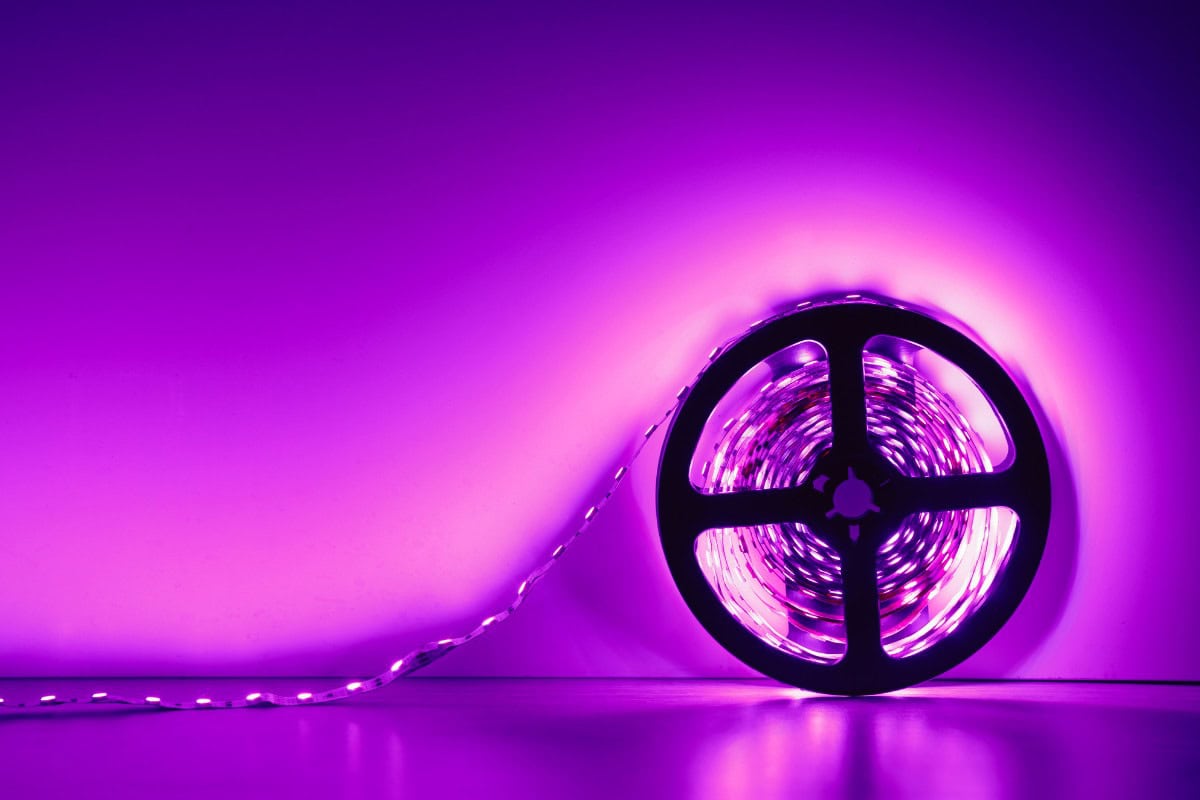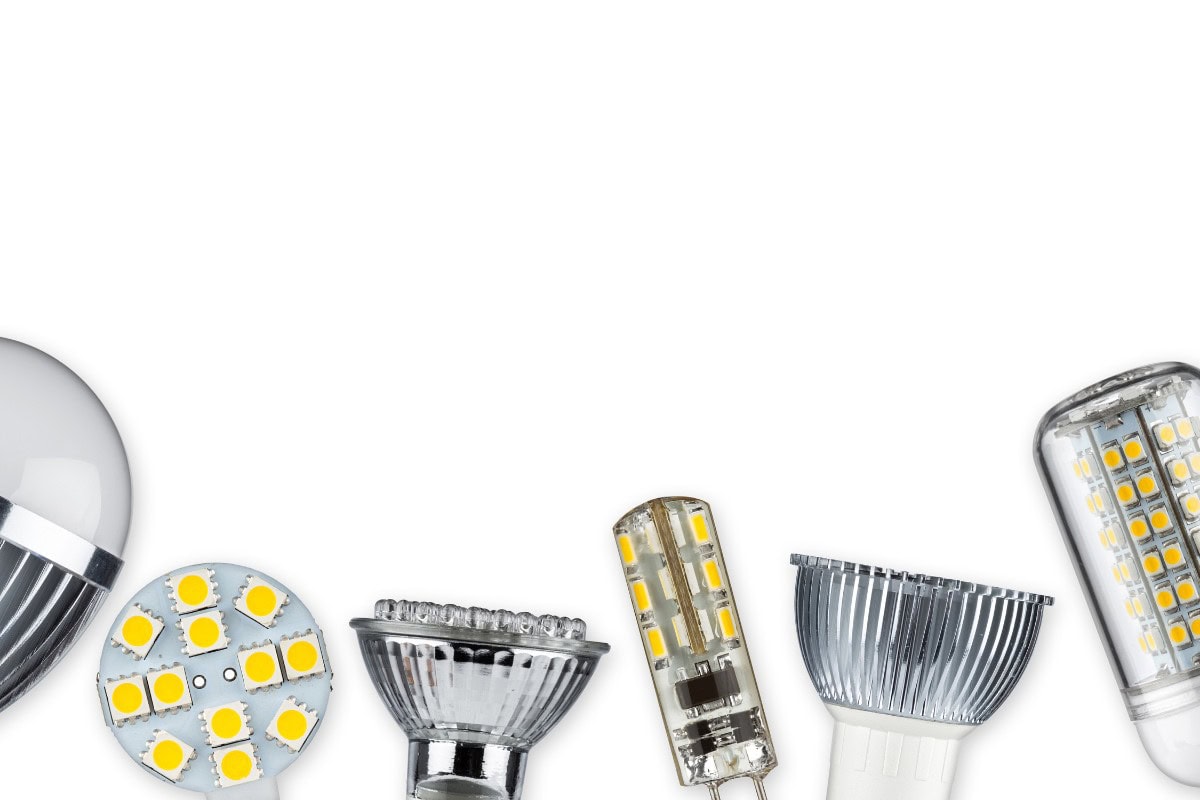Interior and exterior lighting design is changing for the better, largely thanks to the efficiency and accessibility of LED (light emitting diode) lights. LEDs are brighter, have very versatile capabilities, are available in a variety of colors, and are incredibly energy efficient. All of these aspects combine to make LED lighting an increasingly popular choice for homes and businesses.
The last few years have seen pricing for LEDs plummet, much to the glee of consumers. This once cost-prohibitive technology is now priced to compete with the incandescent and fluorescent lighting we’ve relied on for decades. Given its superior performance, long lifespan, and low energy costs, many people are eager to make the switch.
Perhaps one of the most exciting and versatile forms of LED lighting is known as strip lighting (sometimes also known as ribbon lighting or LED tape). Strip lighting offers people the ability to illuminate and highlight areas of their home or business in creative and eye-catching ways without too much fuss.
LED strip lights are definitely making statements all around the world. Let’s take a closer look at this technology to help you understand how it can work for you.
What Are LED Strip Lights
LED strip lights are actually flexible circuit boards covered in small LEDs. The circuit board typically has an adhesive backing, meaning light strip installation really is a matter of “cut, peel, stick.” The thinness of the tape and the low profile of the diodes make strip lighting especially well-suited to creating that “hidden lighting” effect.
You will often see these lights put to good use as accent or task lighting. For instance, placing a strip of bright white LED tape on the underside of your upper kitchen cabinets can create focused task lighting across your kitchen countertop. A thin strip of lighting on the underside of each stair can not only give a staircase plenty of character but also make it safer to navigate, especially in low light conditions.
Many LED strip lights also offer a multicolor option. In some cases, you can choose to illuminate an area of your home with a certain color, or even cycle through different colors on a timer, or with a programmable application. Popular locations for colored LEDs include behind the television set, along the kick panel beneath your lower kitchen cabinets, around a home bar set up, on an outdoor patio, or even in a swimming pool.
These lights are typically designated as either indoor or outdoor, and there are a few other technical considerations to look into before selecting your lights.
For small installation jobs, homeowners can usually handle the relatively simple process themselves. For larger jobs, you may want to get an electrician involved to make sure everything goes smoothly.
Technical Hurdles to Be Aware Of
LED strip lights definitely make installation and setup simple, but you still need to know some technical information before you jump into this or any other electrical project around your home or business.
Water Resistance and Waterproofing
Let’s begin with the simplest consideration: are these lights going to be used indoors or outdoors? LED strip lights can be made water-resistant or even waterproof, but it probably goes without saying that the exposed flexible circuit board on some indoor setups does not get along well with water. Keep this in mind if you plan to use LED lighting near any water source, such as a kitchen sink or in a bathroom, where it would be exposed to lots of steam from the shower.
Cutting Strip Lighting
Most LED strip lights will include clear markings along the circuit board which indicate where it is safe to cut the strip. Cutting an LED strip in any other location will prevent the illumination of the lights beyond the last safe cut point.
When shopping for strip lighting, check to see what the cut point distances are on each strip you are considering. For instance, if you are looking to illuminate the underside of a shelf that is 36 inches in length, choosing an LED strip that has a safe cut point every 10 inches would leave you coming up 6 inches short of full illumination (with a 30-inch strip). However, an LED strip that offered a safe cut point every 6 inches would work perfectly.
Wiring LEDs
Most LED strip lights can be purchased as part of a kit, which will include some connecting wires and a power supply. If a company provides connectors with their light strip, it is often simply a matter of attaching the pre-fitted connector and clipping it on (remember, always positive to positive, and negative to negative.)
If your LED strip light kit does not come with pre-fitted connectors, you may have to do a small bit of soldering to ensure a safe connection. An alternative to this would be to look for kits with pre-fitted connectors.
Find out how you can go about connecting one cut strip to another so that they can all be powered from a single power source, and keep in mind that power supplies will usually indicate a maximum length. A power supply that can illuminate 5 feet of LED tape should not be used for a job larger than that, as it will have a dimming effect on your lighting and reduce your energy efficiency. It’s always better to have more than what you need for a job rather than come up short.
Comparing Costs
As with any upgrade, it can sometimes be difficult to establish a one-to-one ratio when comparing costs. There are several factors that go into a lighting upgrade, and it is a good idea to consider all of them before making your final decision.
Installation
Installing all new lighting fixtures, be they incandescent, fluorescent, or even LED bulbs, is going to be a much larger undertaking than simply using LED tape. Electrical wiring jobs tend to be beyond the scope of even the most diehard DIY enthusiast, so installing permanent fixtures sometimes includes the cost of hiring a professional. LED strip lights, on the other hand, can easily be handled by most people.
Energy Efficiency and Overall Costs
Hands down, LED lights are more efficient than incandescent or fluorescent lights by leaps and bounds, but that comparison really only matters if you plan to replace older-style lights with LED strip lights. Usually, people are installing LED strip lights as a brand-new lighting solution. Adding more lighting onto your existing setup, without making any other changes, will still cause your overall energy costs to go up, albeit slightly.
And remember that not all LED strip lights draw the same amount of energy. Some will have much larger electricity requirements than others, so make sure you understand how the installation of these lights will affect your electric bill.
Extra Features
LED strip lights can do a lot, but as a general rule, the more it does, the more it will cost. So, if you are simply looking for a bit of bright white task or accent lighting, you don’t have to purchase LED strip lights which offer color changing, dimmer switches, motion detectors, etc. Buying only what you need will help to reduce your upfront costs.
Applications
Because LED strip lights are so versatile, they can be used in many ways. Here are some applications to consider.
General/Ambient Lighting
LED strip lights may be an unorthodox choice for the main light source in a room, but that doesn’t mean it can’t be done. With some creative placement and perhaps some housings to help diffuse the light more evenly, LED strips could make a perfectly good solution for general lighting, particularly in small spaces such as powder rooms, closets, hallways, etc.
Task Lighting
One of the greatest things about LEDs is their ability to emit very bright light without drawing tremendous amounts of electricity (such as would be necessary to make an incandescent bulb significantly brighter). This being the case, LED lights are perfectly suited for task lighting, as they create a brighter layer of light that can be focused on a particular area.
Some popular uses of LED strip lights as task lighting include under cabinet installations which act as countertop task lighting, strips placed around a bathroom vanity, desktop or reading area lighting, extra lighting in a garage, or even inside a refrigerator.
Accent Lighting
Because LED strip lights are so thin and have such a low profile, people have come up with incredibly clever ways to use them as accent lighting. For instance, outlining the inner rim of a picture frame can provide focused accent lighting to highlight a photograph or painting. Strips can also easily be placed in the interior of a china or curio cabinet to light up specific pieces or placed around a piece of furniture itself to draw the eye and create a brilliant focal point.
Mood Lighting/Decorative Lighting
This is possibly the most popular choice for LED strip lights because the flexibility and adhesive properties of the light strips have allowed people to get truly creative. Why not have the back of your gaming console emit a glowing green? Or what about placing colored strip lighting on the underside of your couch? A tranquil blue around your aquarium? The possibilities are endless.
Considerations Before Buying
If you, like thousands of other people, are excited at the prospect of what LED strip lights could do in your home, you are probably ready to rush out to the store and pick up your supplies right now.
But before you go, there are a few more things to consider.
Light Density
Two 36-inch strips of LED lighting sit side-by-side on the shelf. One costs significantly less than the other. Why is that? Chances are, it has something to do with light density, or in other words, how many lights are on the strip altogether.
A 36-inch strip of LED tape, which contains 18 diodes, means that a single LED is placed every 2 inches along that strip. The same length with 36 diodes means a light is placed every inch along the strip. The more lights there are, the brighter and more even your lighting will be, but the more you will pay for the hardware. Decide which light density is right for you before installing.
Light Temperature
Lower light temperatures, say around 3000 Kelvin, offer that yellowish glow that we often call “soft white.” The higher the temperature goes beyond that, the more it moves into bright white, and finally, “cold white,” which is closer to 10,000° Kelvin.
Make sure you are happy with the light temperature you are buying, as you do not want your strip lighting to be too weak or too harsh.
Wattage Consumed
There are a number of factors that go into determining how much wattage LED strip lights will consume. And, because strip lighting can be cut, you need to pay extra close attention to make sure that you understand the total amount of wattage you are connecting to each power supply.
It is a common mistake for a consumer to read the packaging of LED strip lights and assume that the entire setup consumes 10 W of energy when in fact, upon closer inspection, the packaging indicates that the setup consumes 10 W of energy per foot.
It is very important that you know this so that you can provide an adequate power supply and accurately estimate your energy expenses.
Dimmer Capability
Many LED strip lights do come off the rack with the ability to work on a dimmer switch, but not all of them. If dimming is important to you, make sure that the LED strip you are choosing has that capability. Be sure to find out if any extra equipment is required before installing.
Light Diffuser
If you don’t like the appearance of light strips or if you want to add an extra layer of protection, consider getting a light strip diffuser. Diffusers help even out the distribution of the light while acting as a heat sink, lowering the operating temperature of the lights. Additionally, these offer a more professional and pleasing look.
Getting Creative With LED Strip Lights
Feeling ambitious? Sure, a little kitchen task lighting is great, but what can you really do with LED strip lighting? Let’s dig into it:
Under Bed Lighting
Everybody hates having to turn on a harsh light when they get up in the middle of the night to use the bathroom or get a drink of water. Why not have a soft blue or orange emanate from under your bed and put it on a motion sensor?
Nightlights
Choose an area in your child’s room to place a small strip of LED lighting, colored or otherwise, to provide a friendly glow to help soothe them to sleep.
Light Therapy in the Bathtub
Imagine this: a strip of color-changing LED along the base of the bathtub. Create your own personal oasis, and get away from it all without leaving your home.
21st-Century Entertainment Center
Pre-program certain light sequences or “recipes” for different activities such as movie watching, gaming, or listening to music. Better yet? Make your light sound reactive for a truly immersive experience.
Outdoor Nightlife at Home
A few strips of LED lighting along a deck, pergola, or porch can instantly change the entire atmosphere of your outdoor entertainment space. Color-changing options are especially popular for outdoor lighting. Think spooky oranges and purples for Halloween, tropical greens and pinks for summertime, or tranquil blues for romantic dinners alfresco.
Submerged, Swimming Pool Lighting
Obviously, waterproofing involves a few extra steps, but color-changing LED strips make a fantastic addition to swimming pools and spas.
As you can see, strip lighting has opened up an entire world of possibilities when it comes to personalizing your decor, inside and out. Light can instantly change the look and feel of any room, and strip lighting is an affordable and easy way to completely redesign the lighting in your home. Go beyond the light bulb and get creative with LED strip lights.









